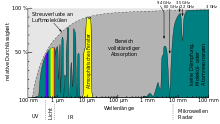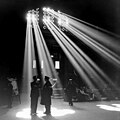daylight
Daylight is the light of the sun ( sunlight ) filtered by the earth's atmosphere or the sunshine that can be seen from sunrise to sunset , i.e. the natural light of the bright day .
description

The light from the high sun , which hits the earth's surface through the earth's atmosphere , corresponds to the color of a black body with a temperature of approx. 5777 Kelvin , but has a more complex light spectrum . This color temperature corresponds to the sun seen from space, without the filtering atmosphere of the earth's surface.
The International Commission on Illumination (CIE) defines some standard light types of class D (daylight) as standard lighting with different color temperatures. These include D50 (5000 K), D55 (5500 K), D65 (6500 K), and D75 (7500 K).
The different spectra of artificial light and daylight mean that some items of clothing have different colors indoors than in daylight.
The brightness of daylight is approximately at illuminance levels between 1 and over 100,000 lx ( lm / m²) ( photopic vision , daytime vision); the lower area enables mesopic vision (transition area to night vision, in which color perception no longer works); glare occurs at higher illuminance levels . The brightness increases sharply from dawn until after noon and then decreases again quickly. The human visual system is sensitive to an enormous range of illuminance levels and adapts to changes in them so that they are generally not perceived during the course of the day.
The ultraviolet component of the sun's rays generates energy in the photosynthesis of the plants and tans , the high infrared component makes the sun's rays have a warming effect - both are hardly reflected by the environment and largely filtered through window glass ( light absorption ); Therefore, in the diffuse light of the shadow and in the interior, one does not get brown and is hardly warmed either: the spectrum of daylight is then significantly more limited.
World map, around April 2, 13:00 UTC (computer graphics): day-night boundary
CIE standard illuminants D in the CIELAB diagram
Rayleigh scattering , formation of the sky blue in daylight
Effects
Daylight is the most important light source on earth and for the daily life of people and other living beings. For Chronobiology daylight is a key factor and affects all metabolic processes in animals and plants, animal migrations and even the mood of the people. In architecture , daylight is used to illuminate the interior of the building, and for this purpose it is specifically directed for optimal use ( exposure , as opposed to lighting ).
For demanding visual astronomy , daylight is an obstacle: It is scattered into the night side of the earth, even after sunset, so that good clear-sighted observation can only begin when the evening astronomical twilight sets in, about 1–1½ hours after sunset - in relation to dawn analogous. With suitable telescopes , however, it is also possible to observe bright stars during the day , that of Venus or occasional supernovae with the naked eye.
Daylight in the interior
Exposure through glass roof and column position
Hong Kong Central Public Pier 9, 21st century







